- Details
- Hits: 1168
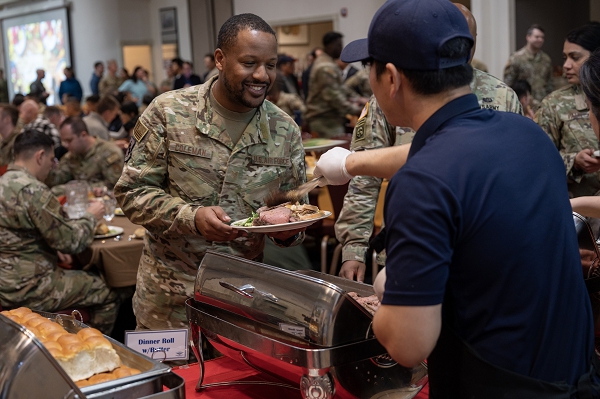
Kunsan Air Base, Republic of Korea. (November 20, 2024): To most Americans, Thanksgiving began in 1621 when pilgrims in Plymouth, Massachusetts joined Native Americans in a feast to celebrate a successful fall harvest. What most do not know is that the tradition did not become an annual event until the Revolutionary War. In this photo by Captain Kaylin Hankerson, U.S. service members dine during the annual Thanksgiving meal hosted by the Korean American Gunsan Alliance, a good neighbor program to connect U.S. personnel to their local community.
Thanksgiving became an annual event during the war for independence when Americans were trying to unify the nation during this terrible struggle. The Continental Congress decided to declare several days of thanksgiving to help inspire our troops to victory. The first such day fell on Nov. 1, 1777, when news of some victories against the British reached their ears.
Later during the Civil War, President Abraham Lincoln called for a day of thanks to be held on the last Thursday in November. The day would be officially known as Thanksgiving.
During World War I, the Red Cross provided Thanksgiving goodies to troops overseas and some local families in France took Soldiers into their homes for the day. During World War II, K-rations issued to the troops were replaced with turkey and cranberry sauce and in recent conflicts the President of the United States has made surprise visits to the troops.
- Details
- Hits: 1375
![]()
Okinawa, Japan. (November 12, 2024): In past wars, Marines in combat had to guess where incoming mortars were coming from. Not today. In this photo by Staff Sergeant Robert Gavaldon, Corporal Jonathan F. Mikita, left, and Sergeant Michael J. Tatay assemble a lightweight counter-mortar radar system. This remarkable device can detect and track incoming rounds fired from separate locations and instantly send early warning messages to friendly troops. The radar also pinpoints the location of the incoming round's launcher for counter-fire from artillery, mortars, or aircraft.
During World War II, radars were mostly used for anti-aircraft defense on ships and carriers. Later adaptations have created a new class of target acquisition radars to track low altitude projectiles like mortars. Here is how the system works:
When an enemy fires a missile or mortar, the system detects and begins to track the projectile while sending out warning messages to the battlefield. Information from a single radar system can be shared with multiple receivers over long distances.
- Details
- Hits: 1850
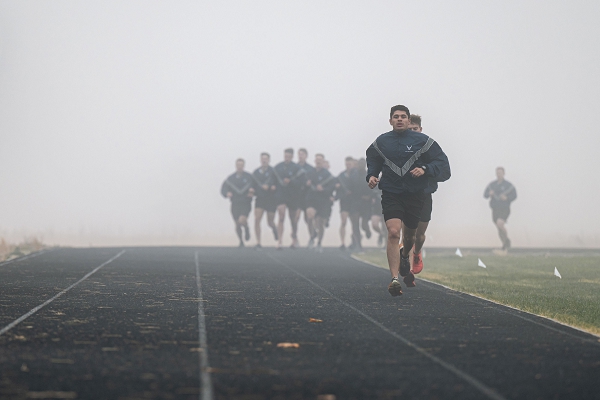
Fairchild Air Force Base, Washington. (November 17, 2024): In this photo by Senior Airman Tiffany Del Oso, Airmen complete a two-mile run on a recent foggy morning. When folks join the military, they instantly discover they must run everywhere. They run to formation, to chow, and endure endless rounds of “motivational” runs. It gets to the point where recruits wonder “Are we training to fight the enemy or run away?”
Seriously, what’s with all this running? The truth is there is probably no better exercise that involves so many muscle groups and contributes as much to overall fitness.
First, you don’t need any special equipment to gain the benefits of running, even shoes (Kung Bushmen were reported to run hundreds of miles through the African desert barefoot). Also, group runs can be done almost anywhere, making it a practical exercise for training large groups of troops in diverse environments.
The second greatest benefit to running is endurance. Regardless of service branch, troops must be able to rapidly move across various terrains during a deployment. Sustaining these actions is considered a crucial element for combat readiness.
- Details
- Hits: 2818
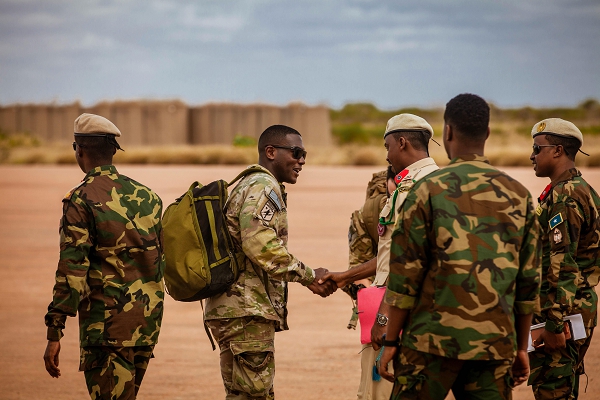
Baledogle Military Airfield, Somalia. (November 13, 2024): The U.S. Army, along with its African counterparts, is helping the war-torn nation of Somalia build a professional military to combat the Al Qaida affiliated terrorist group Al Shabaab. In this photo by Sergeant Jose Albansantos, Captain Darryl Padgett greets a leader of the Somali National Army during a recent Somali National Army-Danab graduation ceremony. The Army is training members of the Somali Danab Brigade, or “Lightning Force,” an elite special operations force within the Somali National Army that specializes in urban warfare. The Al Shabaab terrorists are responsible for a reign of terror that has resulted in a famine that has killed millions.
The Danab Brigade was established in October 2013 with just 150 recruits and has grown to a several thousand-person brigade. Over the years, the unit has regularly conducted strikes that have crippled the Al Shabaab leadership and capabilities. The force has been particularly successful in recapturing territory previously held by the terrorist group.
- Details
- Hits: 1480
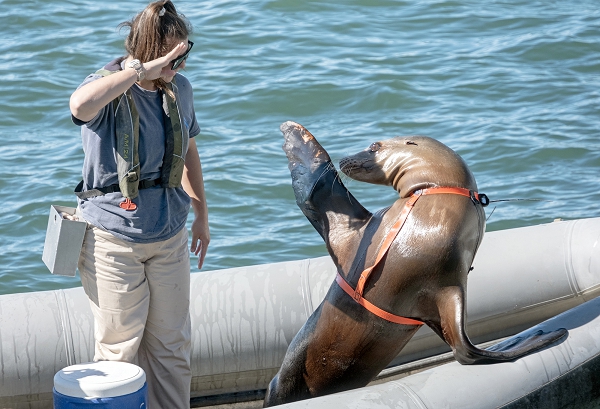
San Diego, California. (November 7, 2024): Who is better at helping U.S. Sailors and Marines deal with underwater threats than the highly intelligent creatures that call the deep their home? In this photo by Todd Hack, a scientist signals a sea lion to salute during an exhibition as part of Fleet Week held here this week. Fleet Week is a great opportunity for service members to participate in various community relations events, showcase their military capabilities and equipment, and enjoy local hospitality.
The Naval Information Warfare Center, through its Marine Mammal Program, has trained dolphins and sea lions as workmates since the 1960s. These highly intelligent animals are trained to detect, locate, mark, and recover objects in harbors, coastal areas, and at depth in the open sea.
California sea lions (Zalophus californianus) are coastal seals native to western North America that are particularly accustomed to working with humans. They have excellent low light vision and underwater directional hearing that allows them to detect and track undersea targets, even in dark or murky waters. These large, imposing beasts also function as security by detecting and helping apprehend unauthorized swimmers that might attempt to harm the Navy’s people, vessels, or harbor facilities.
- Details
- Hits: 1614
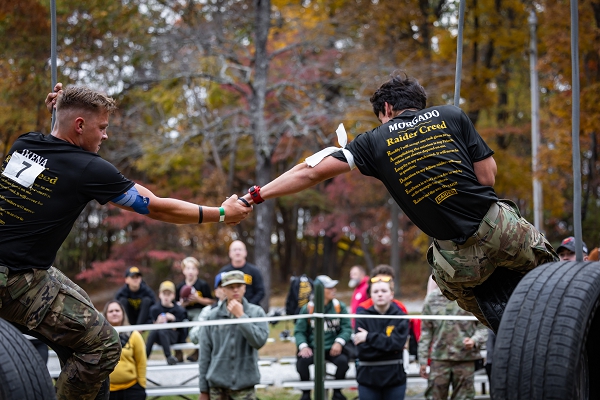
Fort Knox, Kentucky. (November 13, 2024): What do high school students who have high attendance, few discipline problems, and a high graduation rate have in common? Junior Reserve Officer Training (JROTC). In this photo by 2nd Lieutenant Marin-Cruz, JROTC Cadets from Leavenworth High School, Kansas, participate in the Cross-Country Rescue event at the National Raider Challenge 2024. This high intensity competition attracted more than three hundred teams consisting of four thousand cadets from high schools as far away as Guam.
Activities included precision military drill, a Leadership and Academic Bowl, and a demanding Science, Technology, Engineering, and Mathematics (STEM) Camp. The competition was balanced by a tough physical fitness competition known as the Cadet Leadership Challenge.
Established by Congress in 1916, the JROTC is one of the largest citizenship programs for youth in the world, helping high schoolers learn positive, life-long habits and skills. The program helps shape the character of young people at a very critical point in their lives. JROTC instills values of citizenship, service to the United States, and personal responsibility. The program is particularly effective for kids growing up in economically distressed communities. Currently, forty percent of JROTC programs are in inner city schools serving diverse populations.
There are currently more than 1,700 JROTC units taught by a faculty of nearly 4,000 instructors who are mostly retired from active duty, reserve duty, or National Guard. All JROTC Instructors are trained and qualified in accordance with the National Defense Authorization Act 2007.
These highly dedicated instructors teach approximately 314,000 Cadets annually in topics including leadership, health and wellness, physical fitness, American history and government, communications, and emotional intelligence. Many high schools grant core credits for some of the subjects taught in JROTC and the regular Army ROTC offers college scholarships for those who qualify.


